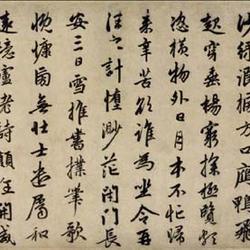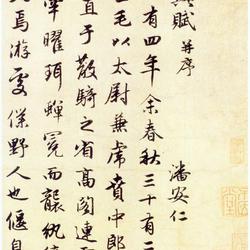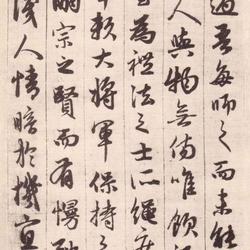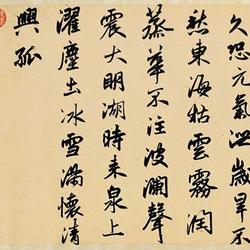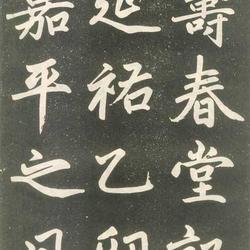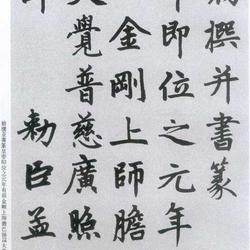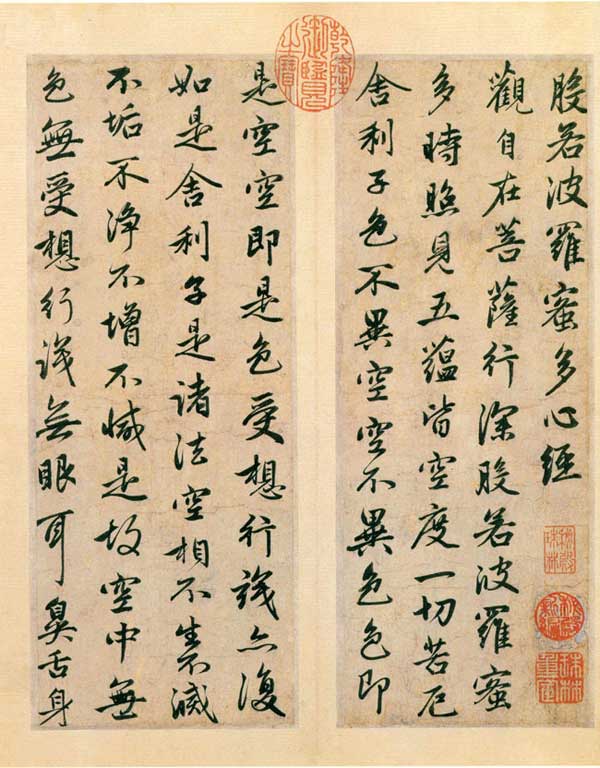
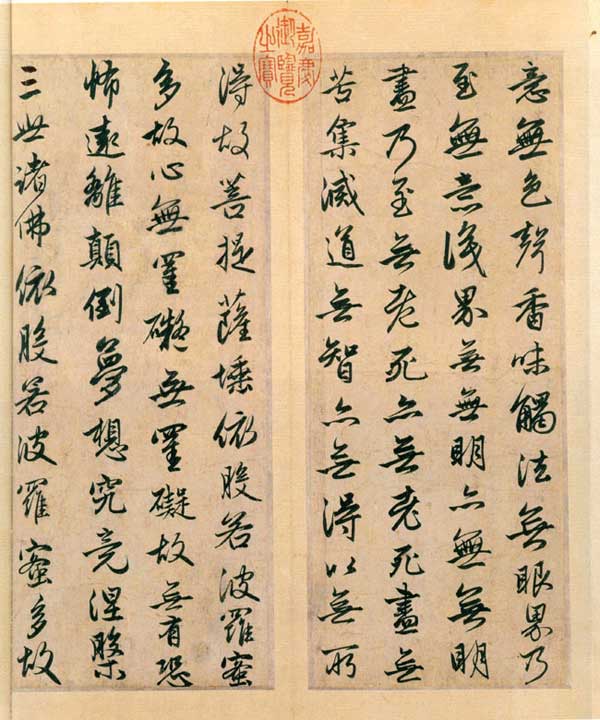
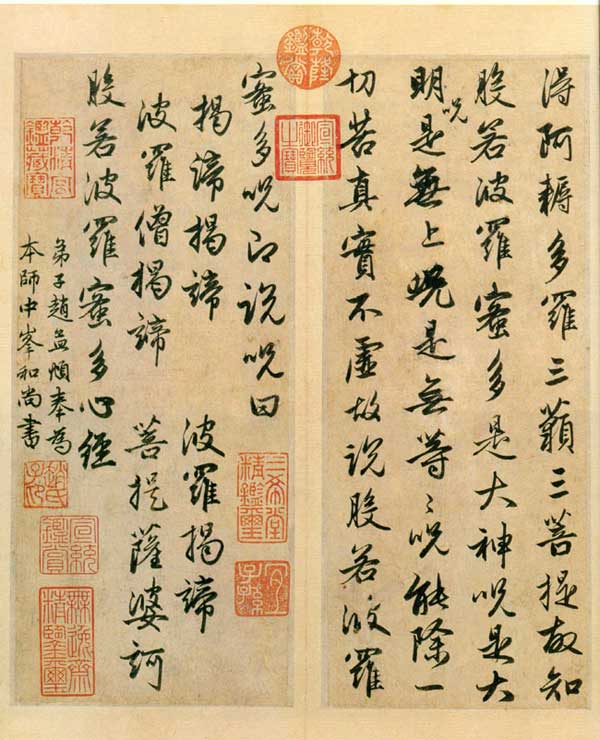
Zhao Mengfu's "The Heart Sutra Running Book", paper, album, collected by Liaoning Museum
Appendix: Respecting the Ancient and Creating the New
Written by Liu Zonghan
Reprinted from "Chinese Heritage" Issue 2, 2004
In the old days, when training young children to learn calligraphy, they should first choose one of the four regular scripts from Ou, Liu, Yan and Zhao to lay a solid foundation. When they grow up, they can either change to other styles or continue to develop according to what they have learned. Among them, "Zhao" refers to Zhao Mengfu of the Yuan Dynasty.
Zhao Mengfu (1254-1322), whose courtesy name was Zi'ang. No. Xuesong Taoist. He is a descendant of Qin Wang Zhao Defang, the son of Song Taizu. Emperor Gaozong of the Southern Song Dynasty had no children, so he adopted Zhao Shen from this clan as his son and passed on the throne to Emperor Xiaozong. In this way, Zhao Mengfu's ancestor became a high official in the Southern Song Dynasty. When he was 19 years old, he served as Zhenzhou Sihu and joined the army. After the death of Song Dynasty, he studied mechanics at home. In the 23rd year of the Yuan Dynasty (1286), Emperor Shizu of the Yuan Dynasty was recommended by Cheng Jufu to become an official in the Yuan Dynasty. After Zhao Mengfu became an official in the Yuan Dynasty, he put forward some reform suggestions on the bad governance of the Yuan Dynasty based on Confucianism, most of which were accepted by the emperor of the Yuan Dynasty. However, Zhao Mengfu's opinions were often opposed by Mongolian ministers. The Yuan Dynasty was a country based on Mongols and Semu people. It was courteous to Han intellectuals and partially accepted Han people's opinions. This was largely due to strategic needs. Once conflicts became acute, the emperor had to favor the Mongols. This made Zhao Mengfu uneasy, so in the 29th year of the Yuan Dynasty, he asked for a foreign post. From then on, until the death of Yingzong in the second year of Zhizhi (1322), although he returned to the court for a time, he spent most of his time serving in other provinces. In the Yuan Dynasty, Zhao Mengfu became a scholar in the Hanlin Academy and became an imperial doctor. After his death, he gave it to Wei Guogong.
Zhao Mengfu had great achievements in both calligraphy and painting. From the "Prajnaparamita Heart Sutra" introduced here, we can see his important position in the history of Chinese calligraphy as a link between the past and the future.
"Heart Sutra" album, 3 pages. Opening 1 before opening 1 is a white drawing of the statue of Guanyin. The first page after the third page is a white-painted image of Veda, and the second and third pages behind it are postscripts by Wang Zhideng of the Ming Dynasty, Zhang Ying, Zhang Zhao, Li Zongwan and others of the Qing Dynasty, and the original title signatures of the Liang Qing Dynasty. Each order is 288 cm long and 108 cm wide. This volume was originally collected by Zhang Ruo'ai in the Qing Dynasty and has seals such as "Lianxue Appraisal" and "Qinglan Jushi". Entering the Qing Palace during the Qianlong period, there are seals stored in the imperial palaces of Qianlong, Jiaqing and Xuantong. The "Heart Sutra" was originally a hand scroll. After entering the Qing Dynasty, it was changed into an album and added with carved sandalwood plywood. The "Avalokitesvara" and "Vedo" before and after the "Heart Sutra" were painted by people from the Qing Dynasty. It is recorded in "Secret Edition of the Pearl Forest in the Secret Palace".
This volume of "Prajna Paramita Heart Sutra" is a representative work of Zhao Mengfu. It can be written freely, cleanly and smoothly, and has its own appearance. However, upon closer analysis, it feels like every word has its own origin. We know that the art of calligraphy and painting in the Song Dynasty had declined by the end of the Southern Song Dynasty. The painting style of Ma Yuan and Xia Gui was mostly empty and rough, with no charm at all. Calligraphy has long lost the vivid charm of the Northern Song Dynasty. The handed down "Self-written Poems" by Zhao Mengjian and "Preface to the Collection of Wooden Chicken" by Wen Tianxiang illustrate this situation. Zhao Mengfu, who lived in this era, tried to correct the current shortcomings and make a difference. Just like the old-fashioned reform that was common in Chinese history, he also advocated "valuing ancient ideas" in calligraphy and painting to revive the decline. In terms of calligraphy, he carefully copied the copybooks of Zhong Yao, Wang Xizhi, Wang Xianzhi and Zhiyong, striving to absorb nutrients from the works of people in the Wei and Jin Dynasties. But at the end of the Song Dynasty and the beginning of the Yuan Dynasty, there was no longer the charm of the Eastern Jin Dynasty with Xuanfeng as the background. The rubbings copied by Zhao Mengfu are far different from the original manuscripts by Zhong, Wang and Zhiyong. In this way, Zhao's calligraphy can only be the shadow of the ancients, but cannot be the reproduction of the ancients. In addition, Jin people sat on the ground and wrote in the air, which was completely different from the Yuan Dynasty's posture of sitting on high chairs and writing according to the case, and the writing effect was completely different. In this way, although Zhao Mengfu subjectively followed the ancients, he actually developed a new style of calligraphy that looked like the ancients. Zhao Mengfu's wholehearted respect for the ancients and his method of copywriting had a great influence on calligraphy since the Ming and Qing Dynasties. As for his use of running script and the structure of small regular script to write large regular script, he created a flexible Zhao style regular script that is different from the rigid regular script of Ou, Liu and Yan styles. Because of its strong adaptability, it can be used to write large plaques and transcribe palace examinations. The larger the volume, the greater the impact. If you look at the Yuan Dynasty, all engravings were in the Zhao style, and you can see how popular the Zhao style was.
Zhao Mengfu wrote more than just one "Prajnaparamita Heart Sutra". This volume was written for monk Zhongfeng. Zhongfeng Shi Mingben, named Zhongfeng, an eminent monk in the Yuan Dynasty, presided over the Huanzhu Temple in Bianshan, Wuxing. Yuan Renzong once conferred the title of Zen Master Foci Yuanzhao. After his death, he was given the posthumous title Puying Guoshi. Zhongfeng's younger brother, Zhao Mengfu, was nine years old, but Zhao was very respectful to Zhongfeng. Since the Northern Dynasties, Buddhist believers have often written sutras themselves or hired people to write sutras as merit. But the scriptures are written. Both used regular script, and Zhao Mengfu wrote the Heart Sutra in running script. It is an unprecedented example in the history of scripture writing.
Wang Zhideng's postscript of this volume says: "Zhao Weiping was good at writing Buddhist scriptures and Zen verses. He has seen so many things that I can't even point him out. Because his predecessor must have been an eminent monk, he devoted himself to Zhuqian's wonderful scriptures, not even a single book is enough." Yes." In fact, in the special dynasty of the Yuan Dynasty, intellectuals, whether they were in the opposition or in official positions, were somewhat depressed. Some of them escaped from Zen to Taoism, or they fell in love with mountains and rivers, or even lingered in Fengyue, writing dramas as calligraphers. It is impossible for these people to have all been eminent monks before. As for Zhao Mengfu, on the one hand, he was despised by the survivors because he served in the Yuan Dynasty as a member of the Zhao and Song clan; on the other hand, he was ostracized by the Mongolian ministers in the Yuan Dynasty court, so that he had to confess to the emperor: "The past is no longer something to talk about, and it will be Loyalty and direct repayment to the emperor." In this state of mind, he wrote a poem "Sin Out", saying:
In the mountains it is Polygala, and out of the mountains it is grass.
As the old saying goes, it's never too early to see the bitterness of things.
Who caused me to fall into the net of dust and be entangled gracefully?
In the past, I was a gull on the sea, now I am a bird in a cage.
A "caged bird" looking for sustenance from Buddhism may have nothing to do with whether his predecessor was a eminent monk or not. What's more, Zhao Mengfu also wrote Taoist classics such as "Dongxuan Natural Nine Heavens Ascension Chapter Sutra", which has nothing to do with eminent monks. Wang Zhideng was one of the so-called "mountain men" in the late Ming Dynasty. Shen Defu, a man at that time, wrote in "Wanli Yehuobian·Shanren". Satirize Wang Zeng. The crudeness of Wang's postscript in this volume proves that Shen's sarcasm is quite justified.

